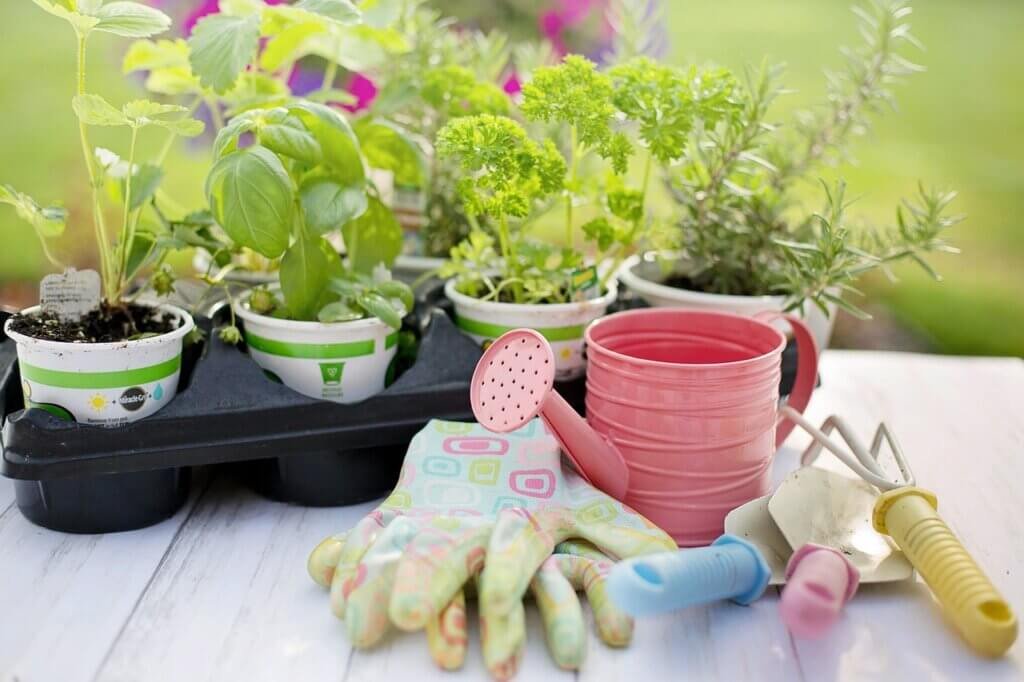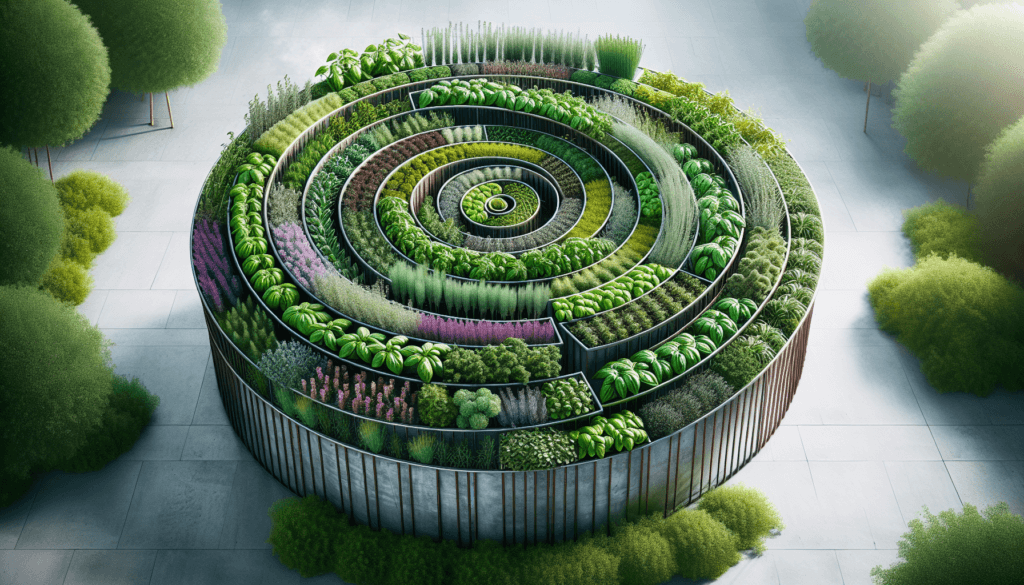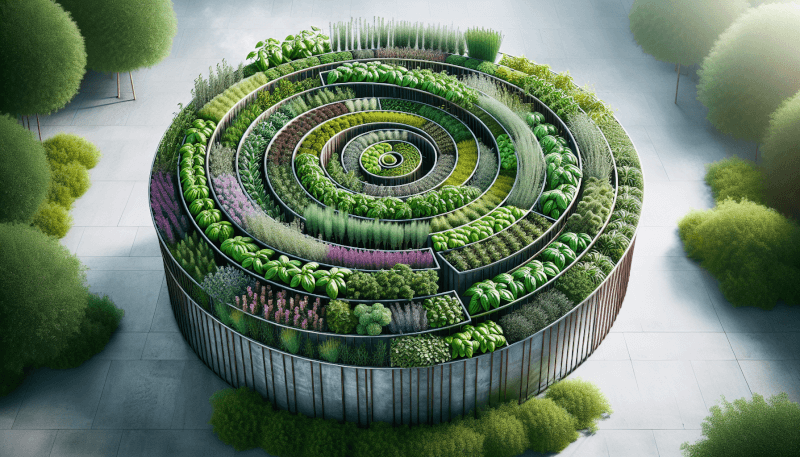Have you ever wanted to create a stunning and practical herb garden in your urban space, but didn’t know where to start? Look no further! In this article, we will show you how to easily design and build a beautiful herb spiral that not only adds a touch of natural beauty to your garden but also maximizes space and makes it easy to grow a wide variety of herbs. Say goodbye to boring and limited herb gardens – with our step-by-step guide, you’ll have a thriving and eye-catching herb spiral in no time!

Choosing the Right Location
Considering sunlight and shade
When choosing a location for your herb spiral, it is essential to consider the amount of sunlight and shade that the area receives throughout the day. Most herbs thrive in full sun, receiving at least six hours of direct sunlight daily. However, some herbs, like mint and parsley, can tolerate partial shade. By observing the sunlight patterns in your garden, you can determine the best spot for your herb spiral and ensure that your herbs will receive the appropriate amount of light to grow healthy and flavorful.
Assessing soil quality
Another crucial factor to consider when selecting the location for your herb spiral is the quality of the soil. Herbs prefer well-drained soil with a pH level ranging from neutral to slightly acidic. It is recommended to assess the soil’s structure, fertility, and moisture content before deciding on the site. Conduct a soil test or consult with a local gardening expert to determine if any amendments or improvements are needed to optimize the soil quality for your herb spiral.
Accounting for accessibility
In addition to sunlight and soil quality, accessibility is an important consideration when choosing the location for your herb spiral. Make sure that the spiral is easily accessible for regular maintenance, harvesting, and replanting. Consider placing the herb spiral close to your kitchen or a convenient pathway so that you can easily reach it when needed. By selecting a location that is both functional and easily accessible, you can ensure a more enjoyable and efficient gardening experience.
Designing the Herb Spiral
Understanding the concept of a herb spiral
A herb spiral is a unique and efficient way to grow a variety of herbs in a compact space. It is a circular raised bed garden that is built in a spiral shape, resembling a snail shell. The spiral design allows you to create different microclimates within the herb spiral, providing optimal growing conditions for a range of herbs with varying sunlight and moisture requirements. The spiral shape also maximizes space utilization, making it an ideal choice for urban gardens with limited area.
Determining the size and shape
Before constructing your herb spiral, it is important to determine the appropriate size and shape for your garden space. The size of the herb spiral will depend on the amount of herbs you wish to grow and the available area. As a general guideline, a 6-8 feet diameter spiral is suitable for most home gardens. However, you can adjust the size according to your needs and available space. The height of the herb spiral should be around 3-4 feet, allowing for easy access and planting.
Selecting appropriate materials
When designing your herb spiral, consider using materials that are durable, non-toxic, and visually appealing. Popular materials for constructing the outer wall of the herb spiral include bricks, stones, or untreated lumber. You may also incorporate recycled materials or repurpose items such as old tires or wine barrels. Inside the spiral, use layers of organic matter, such as straw, leaves, and compost, to create fertile soil. Remember to choose materials that are safe for growing herbs and will complement the overall aesthetics of your garden.
Planning the layout
Before starting the construction of your herb spiral, it is essential to plan the layout of the spiral. Consider the sun exposure and shade patterns within the spiral and how these will affect the growth of different herbs. Place herbs with higher sunlight requirements towards the top of the spiral, while herbs that prefer shade can be placed towards the bottom or shaded areas. Visualize the arrangement of herbs and plan the planting pockets accordingly to optimize space and ensure a harmonious and aesthetic herb spiral.

Preparing the Site
Clearing the area
To prepare the site for your herb spiral, start by clearing the area of any plants, debris, or weeds. Remove any large rocks or obstacles that may hinder the construction or growth of your herb spiral. This will provide a clean slate for building and ensure proper drainage and overall stability.
Removing weeds and grass
After clearing the area, it is important to remove any weeds or grass that may compete with your herbs for nutrients and water. Use a garden hoe or a weed trimmer to uproot the weeds and grass, ensuring that you remove their roots as well to prevent regrowth. This step will help create a weed-free environment for your herb spiral and promote healthier herb growth.
Leveling the ground
Once the area is clear of weeds and grass, it is important to level the ground for the construction of your herb spiral. Use a shovel or a rake to remove any bumps or depressions in the soil and create a smooth and level surface. This will ensure the stability of the herb spiral and provide an even planting surface for your herbs.
Creating a base layer
To enhance the drainage and fertility of your herb spiral, create a base layer using organic matter such as straw, leaves, or wood chips. This layer will serve as a natural weed barrier, retain moisture, and provide additional nutrients to the herbs. Spread a thick layer of organic matter evenly across the leveled ground within the herb spiral area, ensuring full coverage from the outer wall to the center.
Building the Herb Spiral
Constructing the outer wall
The outer wall of the herb spiral acts as a structural support for the entire spiral and helps create the unique shape. Use your selected materials, such as bricks or stones, to construct a sturdy and visually appealing wall. Lay the materials in a spiral shape, starting from the outer edge and working your way towards the center. Ensure that the wall is well-built and stable, as it will hold the soil and plants in place.
Layering with soil and compost
Once the outer wall is constructed, it is time to fill the herb spiral with soil and compost. Layer the soil and compost mixture from the base layer, gradually filling up the spiral, making it slightly higher towards the center. This layering technique helps create different microclimates and allows for better drainage and moisture retention. Compact each layer gently as you fill, ensuring that the soil and compost are evenly distributed throughout the herb spiral.
Creating planting pockets
To accommodate different herbs with varying needs, create planting pockets within the herb spiral. Use a trowel or your hands to carefully carve out small spaces between the layers of soil and compost. These pockets will serve as individual planting spots for each herb, allowing them to grow without competing for space, nutrients, and sunlight. Make sure to consider the growth habits and spacing requirements of each herb when creating the planting pockets.
Adding a central feature
To enhance the beauty and functionality of your herb spiral, consider adding a central feature such as a small fountain, statue, or a focal point plant. This central feature will not only serve as a visual centerpiece but can also provide additional benefits such as attracting pollinators or creating a soothing ambiance in your garden. Choose a feature that aligns with your personal preferences and complements the overall design and theme of your herb spiral.

Choosing Suitable Herbs
Considering culinary needs
When selecting herbs for your spiral, it is important to consider your culinary needs and personal preferences. Choose herbs that you regularly use in cooking and ones that will add flavor and variety to your meals. Popular culinary herbs include basil, rosemary, thyme, oregano, and cilantro. Experiment with different flavors and aromas to create a diverse herb selection that can elevate your dishes and bring joy to your culinary experiences.
Evaluating growth requirements
Each herb has specific growth requirements in terms of sunlight, moisture, and soil conditions. Evaluate these requirements to ensure that you choose herbs that will thrive in your area and within the microclimate created by your herb spiral. Consider factors such as the amount of sunlight your herb spiral receives, the water retention capabilities of your soil, and the overall climate of your region. By selecting herbs that match these conditions, you will increase the chances of success and achieve a healthy herb garden.
Selecting companion plants
Companion planting is a gardening technique where you grow plants together to maximize their growth potential and deter pests. When choosing herbs for your spiral, consider companion plants that can help improve the health and productivity of your herbs. For example, planting marigolds around your herb spiral can deter harmful insects, while planting chives near roses can help repel aphids. By selecting herbs that have positive interactions with each other, you can create a balanced and thriving ecosystem within your herb spiral.
Planting and Caring for Herbs
Transplanting herb seedlings
Once you have selected your herbs, it’s time to transplant them into your herb spiral. Carefully remove each herb from its container and gently loosen the rootball. Dig a hole in one of the planting pockets and place the herb in, making sure the top of the rootball is level with the surrounding soil. Firmly press the soil around the herb to eliminate any air pockets and provide stability. Repeat this process for each herb, considering their spacing requirements and growth habits.
Carefully spacing the plants
Proper spacing is crucial for healthy herb growth and to prevent overcrowding. Consult a plant spacing chart or gardening resource to determine the appropriate distance between each herb in your herb spiral. Overcrowded herbs can compete for resources, become more prone to diseases, and hinder the overall growth of the spiral. By carefully spacing your herbs, you will create an environment that allows each herb to flourish and reach its full potential.
Providing regular watering
Watering is a vital aspect of herb care, especially during the initial stages after transplanting. Herbs generally prefer moderately moist soil, so it is important to water them regularly and provide consistent moisture. Be mindful not to overwater, as excessive moisture can lead to root rot and other issues. To gauge the moisture level, use your finger or a moisture meter to check the soil’s moisture content before watering. Adjust the watering frequency accordingly based on the specific needs of each herb and the prevailing weather conditions.
Applying organic fertilizers
To enhance the growth and productivity of your herbs, consider applying organic fertilizers throughout the growing season. Organic options such as compost, worm castings, or compost tea are excellent choices as they enrich the soil with essential nutrients and improve its fertility. Follow the recommended application rates provided by the manufacturer or gardening experts to prevent overfertilization. Applying organic fertilizers regularly ensures that your herbs receive the necessary nutrients to thrive and produce abundant foliage.
Weeding and pruning
Regular weeding is crucial to maintain a healthy and thriving herb spiral. Remove any weeds that may compete with your herbs for resources and eliminate potential hosts for pests and diseases. Monitor your herb spiral regularly and hand-pull any weeds as soon as they appear. Additionally, pruning your herbs helps promote bushier growth and prevents them from becoming leggy. Prune herbs such as basil, mint, and sage regularly to encourage new growth and maintain the desired shape and size.

Managing Pests and Diseases
Identifying common herb pests
Herbs, like any other plants, can be susceptible to various pests that can cause damage to your garden. Common herb pests include aphids, whiteflies, snails, slugs, and caterpillars. Regularly inspect your herbs for signs of pest infestations, such as chewed leaves, sticky residue, or stunted growth. Identifying these pests early can help you take prompt action and prevent them from spreading and causing significant damage to your herb spiral.
Using organic pest control methods
When managing herb pests, it is recommended to use organic pest control methods to avoid harmful chemicals in your garden. Homemade remedies such as neem oil spray, garlic spray, or soap solution can effectively control many pests without causing harm to beneficial insects. Introduce beneficial insects like ladybugs, lacewings, or parasitic wasps to your garden as they can naturally help control pest populations. By employing organic pest control methods, you can maintain a healthy balance in your herb spiral and protect the environment.
Preventing diseases through proper care
Diseases can be detrimental to the health and vitality of your herbs. To prevent diseases from spreading within your herb spiral, practice good garden hygiene and proper care. Avoid overwatering, as excessive moisture can promote fungal growth. Water in the early morning so that leaves have time to dry before evening, reducing the risk of fungal infections. Regularly remove any dying or diseased plant material and dispose of them properly. Proper air circulation, adequate spacing, and healthy soil conditions also contribute to disease prevention and overall plant health.
Harvesting and Using Herbs
Knowing when to harvest
Harvesting herbs at the right time ensures optimal flavor, aroma, and nutrient content. Generally, herbs are best harvested when they are at their peak growth, before they flower. The flavor and aroma are most concentrated at this stage. Harvest in the early morning when the essential oils are at their highest, just before the sun evaporates them. Regularly inspect your herbs and harvest individual leaves or stems as needed, taking care not to remove more than one-third of the plant at a time.
Harvesting techniques
Depending on the herb, there are different techniques for harvesting. For herbs with softer stems like basil or cilantro, pinch or cut the stems just above a pair of leaves to encourage branching. For woody herbs like rosemary or thyme, use sharp pruning shears to make clean cuts above the leaf nodes. Avoid tearing or ripping the plant material, as this can cause damage and impact regrowth. Proper harvesting techniques preserve the health of your herbs and allow for continuous production throughout the growing season.
Preserving herbs for future use
To enjoy your herbs beyond the growing season, consider preserving them for future use. Drying is a popular method for preserving herbs, as it retains their flavor and aroma. Hang herb bundles upside down in a well-ventilated, dry area until they are fully dry. Store the dried herbs in airtight containers away from sunlight and moisture. Another preservation method is freezing. Chop the herbs, place them in ice cube trays with a little water or olive oil, and freeze. The frozen herb cubes can be easily added to soups, stews, and other dishes as needed.
Using herbs in cooking and herbal remedies
The main joy of growing herbs is being able to use them in your cooking and herbal remedies. Experiment with different flavor combinations and discover how herbs can elevate your dishes. Use fresh herbs as garnishes, infuse them in oils, vinegars, or syrups, or incorporate them into marinades, rubs, and dressings. Additionally, many herbs have medicinal properties and can be used in homemade herbal remedies. Consult reliable herbal resources to learn about the healing properties of herbs and how to use them safely and effectively.

Maintaining the Herb Spiral
Regularly maintaining the structure
To keep your herb spiral in good shape, it is important to regularly maintain the structure. Inspect the outer wall for any signs of deterioration or shifting and repair as necessary. Remove any debris or fallen leaves from the surface of the spiral. Inspect the planting pockets for any soil erosion or compaction and refill with fresh soil and compost if needed. Regular maintenance ensures the longevity and stability of your herb spiral, allowing you to continue enjoying its benefits for years to come.
Renewing soil and compost
Over time, the soil within your herb spiral may become depleted of nutrients and require replenishment. Consider adding fresh compost or organic fertilizer each growing season to improve the soil’s fertility. Additionally, observe any changes in soil texture, drainage, or pH and make adjustments as needed. Monitoring the soil conditions and renewing the soil regularly will help maintain a healthy and productive herb spiral.
Trimming and replanting as necessary
As your herbs grow and mature, some may require trimming or replanting to ensure healthy growth and appearance. Prune any overgrown or leggy herbs to promote a bushier form. If any herbs have completed their growth cycle or are no longer producing, replace them with new herbs to maintain a continuous harvest. Regularly assess the overall health and aesthetics of your herb spiral and make necessary adjustments to keep it vibrant and well-maintained.
Monitoring and addressing issues
Keep a close eye on your herb spiral and monitor for any signs of pests, diseases, or other issues. Early detection and prompt action can prevent the spread of problems and minimize damage. Regularly inspect the leaves, stems, and soil for any abnormalities or changes in color, texture, or growth. If needed, consult gardening resources or seek advice from local experts to diagnose and address any issues that may arise. By being vigilant and proactive, you can maintain a healthy and thriving herb spiral.
Share and Enjoy Your Herb Spiral
Inviting friends and neighbors
One of the joys of having a herb spiral is being able to share your abundant harvest with friends and neighbors. Invite them to visit your garden and experience the beauty and functionality of your herb spiral first-hand. Encourage them to taste and pick their favorite herbs to use in their own dishes. Sharing your garden with others creates a sense of community and inspires others to start their own herb spirals or gardens.
Host a workshop or demonstration
If you are passionate about gardening and want to inspire others, consider hosting a workshop or demonstration on creating a herb spiral. Share your knowledge and experiences, guiding others in the step-by-step process of designing, building, and maintaining their own herb spirals. Provide hands-on activities and engage participants in planting and caring for herbs. By sharing your expertise, you can empower others to embrace gardening and experience the joys and benefits of a herb spiral.
Share surplus herbs
As your herb spiral thrives, you may find yourself with an abundance of herbs. Share the surplus with friends, family, and neighbors who may not have their own herb gardens. Encourage them to experiment with new flavors and explore the world of fresh herbs. Consider creating small herb bundles or herb-infused oils as gifts. Sharing your surplus not only reduces waste but also spreads joy and appreciation for the beauty and flavors of herbs.
Enjoy the benefits of the spiral
Finally, make sure to take time to appreciate and enjoy the benefits of your herb spiral yourself. Step into your garden, breathe in the fresh aromas, and savor the beauty of your thriving herbs. Experience the satisfaction of harvesting your own fresh and flavorful herbs for your culinary creations or herbal remedies. Take moments to relax and unwind in your herb spiral, surrounded by nature and the therapeutic qualities of plants. Embrace the serenity and productivity that your herb spiral brings to your urban garden.


